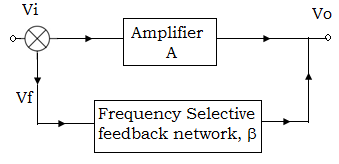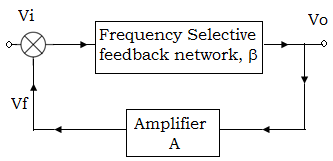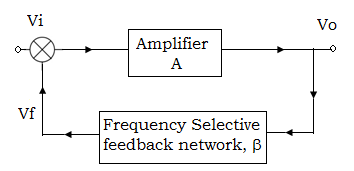This set of Linear Integrated Circuit Multiple Choice Questions & Answers (MCQs) focuses on “Basic Principles of Sine Wave Oscillator-1”.
1. What is Barkhausen criterion for oscillation?
a) Aß > 1
b) Aß < 1
c) Aß = 1
d) Aß ≠ 1
View Answer
Explanation: The Barkhausen criterion for oscillation is Aß = 1.
Where, A-> gain of amplifier and ß-> transfer ratio.
2. At what condition the output signal can be continuously obtained from input signal?
a) When the product of input voltage and feedback voltage is equal to 1
b) When the product of amplifier gain and transfer ratio is equal to 1
c) When the product of feedback voltage and transfer ratio is equal to 1
d) When the product of amplifier gain and input voltage is equal to 1
View Answer
Explanation: When Aß=1, the feedback signal will be equal to the input signal. At this condition, the circuit will continue to provide output, even if the external signal is disconnected. This is because the amplifier cannot distinguish between external signal and signal from the feedback circuit. Thus, output signal is continuously obtained.
3. An oscillator is a type of
a) Feedforward amplifier
b) Feedback amplifier
c) Waveform amplifier
d) RC amplifier
View Answer
Explanation: An oscillation is a type of feedback amplifier in which a part of output is fed back to the input via a feedback circuit.
4. Find the basic structure of feedback oscillator.
a) 
b) 
c) 
d) None of the mentioned
View Answer
Explanation: The above mentioned diagram is the basic structure of feedback oscillator. It consists of an amplifier, to the external input (vi) is applied and it have a feedback network from which the feedback signal (vf) is obtained.
5. What is the condition to achieve oscillations?
a) |Aß|=1
b) ∠Aß=0o
c) ∠Aß=multiples of 2π
d) All the mentioned
View Answer
Explanation: All the conditions should be simultaneously satisfied to achieve oscillations.
6. What happens if |Aß|<1
a) Oscillation will die down
b) Oscillation will keep on increasing
c) Oscillation remains constant
d) Oscillation fluctuates
View Answer
Explanation: If |Aß| becomes less than unity, the feedback signal goes on reducing in each feedback cycle and oscillation will die down eventually.
7. How sustained oscillation can be achieved?
a) Maintaining |Aß| slightly greater than unity
b) Maintaining |Aß| equal to unity
c) Due to non-linearity of transistor
d) Due to use of feedback network
View Answer
Explanation: When |Aß| is kept slightly greater than unity the signal, however, cannot go on increasing and get limited due to non-linearity of the device (that is transistor enters into saturation). Thus, it is the non-linearity of the transistor because of which the sustained oscillation can be achieved.
8. Why it is difficult to maintain Barkhausen condition for oscillation?
a) Due to variation in temperature
b) Due to variation in supply voltage
c) Due to variation in components life time
d) All of the mentioned
View Answer
Explanation: The Barkhausen condition |Aß|=1 is usually difficult to maintain in the circuit as the value of A and ß vary due to temperature variations, aging of components, change of supply voltage etc.
9. Name the type of noise signal present in the oscillation?
a) Schmitt noise
b) Schottky noise
c) Saturation noise
d) None of the mentioned
View Answer
Explanation: Schottky noise is the noise signal always present at the input of the transistor due to variation in the carrier concentration.
10. A basic feedback oscillator is satisfying the Barkhausen criterion. If the ß value is given as 0.7072, find the gain of basic amplifier?
a) 2.1216
b) 0.7072
c) 1
d) 1.414
View Answer
Explanation: Barkhausen criterion for oscillation is given as Aß=1
=> A=1/ ß = 1/0.7072 = 1.414.
11. The feedback signal of basic sine wave oscillator is given as
a) Vf = Aß ×Vo
b) Vf = Aß ×Vi
c) Vf = Aß × (Vo/ Vi)
d) Vf = Aß × (Vi/ Vo)
View Answer
Explanation: The feedback signal of an oscillator is given as the product of external applied signal & the loop gain of the system.
=> Vf= Aß ×Vi.
12. Express the requirement for oscillation in polar form
a) Aß =1∠360o
b) Aß =1∠90o
c) Aß =1∠πo
d) Aß =1∠270o
View Answer
Explanation: There are two requirements for oscillation
1. The magnitude of Aß=1
2. The total phase shift of Aß=0o or 360o.
Sanfoundry Global Education & Learning Series – Linear Integrated Circuits.
To practice all areas of Linear Integrated Circuits, here is complete set of 1000+ Multiple Choice Questions and Answers.
If you find a mistake in question / option / answer, kindly take a screenshot and email to [email protected]
